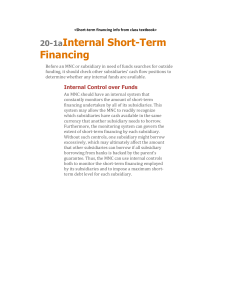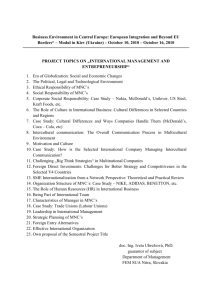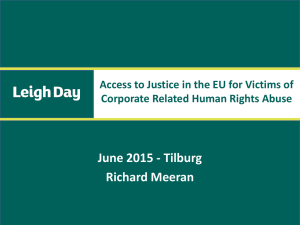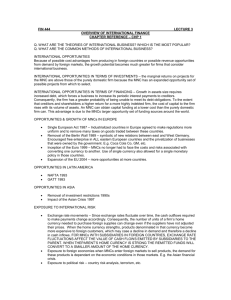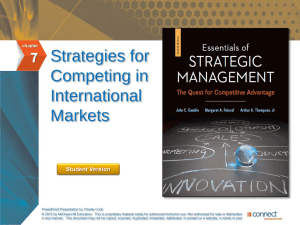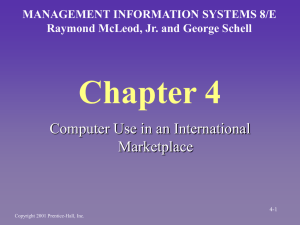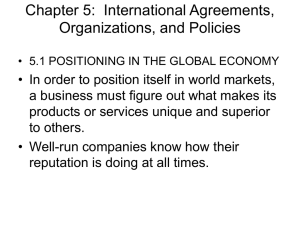CHAPTER 2 The Political, Economic,
advertisement
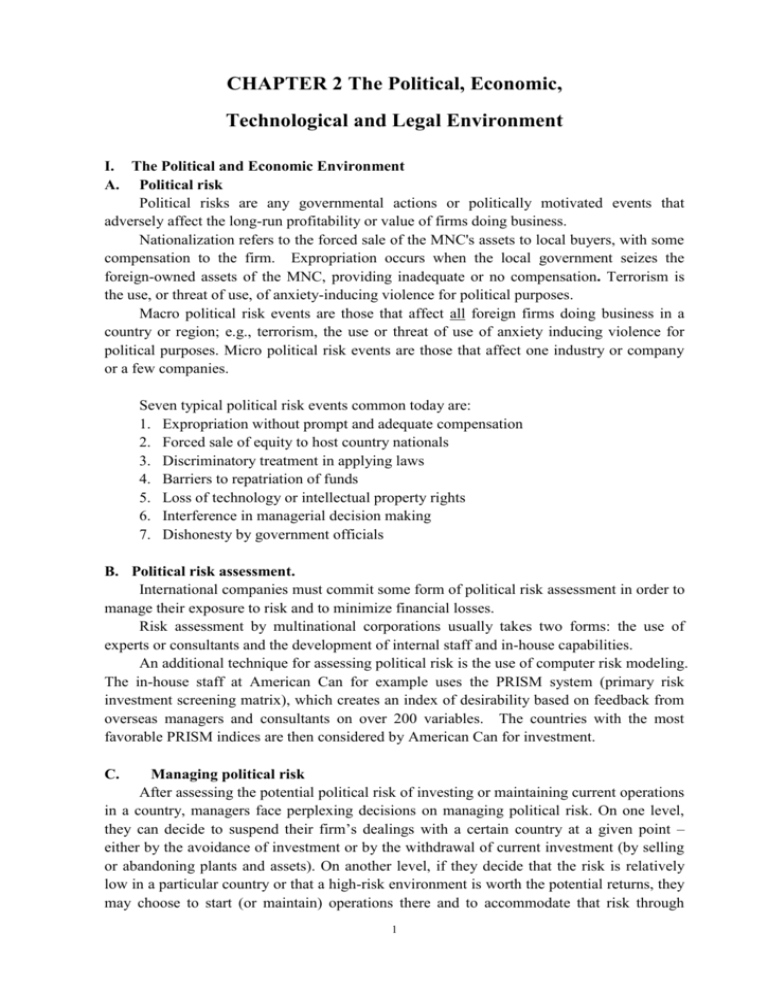
CHAPTER 2 The Political, Economic, Technological and Legal Environment I. The Political and Economic Environment A. Political risk Political risks are any governmental actions or politically motivated events that adversely affect the long-run profitability or value of firms doing business. Nationalization refers to the forced sale of the MNC's assets to local buyers, with some compensation to the firm. Expropriation occurs when the local government seizes the foreign-owned assets of the MNC, providing inadequate or no compensation. Terrorism is the use, or threat of use, of anxiety-inducing violence for political purposes. Macro political risk events are those that affect all foreign firms doing business in a country or region; e.g., terrorism, the use or threat of use of anxiety inducing violence for political purposes. Micro political risk events are those that affect one industry or company or a few companies. Seven typical political risk events common today are: 1. Expropriation without prompt and adequate compensation 2. Forced sale of equity to host country nationals 3. Discriminatory treatment in applying laws 4. Barriers to repatriation of funds 5. Loss of technology or intellectual property rights 6. Interference in managerial decision making 7. Dishonesty by government officials B. Political risk assessment. International companies must commit some form of political risk assessment in order to manage their exposure to risk and to minimize financial losses. Risk assessment by multinational corporations usually takes two forms: the use of experts or consultants and the development of internal staff and in-house capabilities. An additional technique for assessing political risk is the use of computer risk modeling. The in-house staff at American Can for example uses the PRISM system (primary risk investment screening matrix), which creates an index of desirability based on feedback from overseas managers and consultants on over 200 variables. The countries with the most favorable PRISM indices are then considered by American Can for investment. C. Managing political risk After assessing the potential political risk of investing or maintaining current operations in a country, managers face perplexing decisions on managing political risk. On one level, they can decide to suspend their firm’s dealings with a certain country at a given point – either by the avoidance of investment or by the withdrawal of current investment (by selling or abandoning plants and assets). On another level, if they decide that the risk is relatively low in a particular country or that a high-risk environment is worth the potential returns, they may choose to start (or maintain) operations there and to accommodate that risk through 1 adaptation to the political regulatory environment. That adaptation can take many forms, each designed to respond to the concerns of a given local area. Some means of adaptation suggested by Taoka and Beeman are given here: 1. Equity sharing includes the initiation of joint ventures with nationals to reduce political risks 2. Participative management refers to actively involve nationals, including those in labor organizations or government, in the management of the subsidiary. 3. Localization of the operation modifies the subsidiary’s name, management style, and so forth, to suit local tastes. Localization seeks to transform the subsidiary from a foreign firm to a national firm. 4. Development assistance includes the firm’s active involvement in infrastructure development (foreign-exchange generation, local sourcing of materials or parts, management training, technology transfer, securing external debt, and so forth). In addition to avoidance and adaptation, two other means of risk reduction available to managers are dependency and hedging. Dependency - keeping the subsidiary and host nation dependent on the parent corporation. It can be maintained with four methods: 1. Input control – parent controls the key inputs. 2. Market control - parent controls means of distribution. 3. Position control - key positions in the hands of expatriate or home office managers. 4. Staged contribution strategies – Parent announces planned increased investment in the host country for successive years. Hedging - (minimizing losses associated with political events) can take place through: 1. Political risk insurance - An insurance policy offered in most industrialized countries 2. Local debt financing - Firm can withhold debt repayment in lieu of compensation for losses incurred to political risk factors. D. Managing Terrorism Risk Companies have developed a number of techniques for managing the risk of terrorism, including developing a benevolent image through charitable contributions to the local community; minimizing publicity in host countries —maintain a low profile; putting together teams to monitor patterns of terrorism around the world; and increasing security measures abroad. E. Economic risk A country's level of economic development generally determines its economic stability and therefore its relative risk to a foreign firm. A country’s ability or intention to meet its financial obligations determines its economic risk. The economic risk incurred by a foreign corporation usually falls into one of two main categories; its investment in a specific country may become unprofitable (1) if the government abruptly changes its domestic monetary or fiscal policies or (2) if the government decides to modify its foreign-investment policies. The latter situation would threaten the ability of the company to repatriate its earnings and would create a financial or interest-rate risk. 2 The risk of exchange-rate volatility results in currency translation exposure to the firm when the balance sheet of the entire corporation is consolidated and may cause a negative cash flow from the foreign subsidiary. Currency translation exposure occurs when the value of one country’s currency changes relative to another. The four primary methods of analyzing economic risk (recommended by John Mathis, senior financial policy analyst for the World Bank), or a country's creditworthiness, are: quantitative, qualitative, combination of both, and the checklist approach. II. The Regulatory Environment The prudent international manager consults both local and headquarters' legal services in order to comply with host country regulations and to maintain cooperative long-term relationships in the local area. While the regulatory environment for the international manager consists of the many local laws and the court systems in those countries in which he or she operates, certain other legal issues are covered by international law. International law is the law that governs relationships between sovereign nations. The United Nations Convention on Contracts for the International Sale of Goods (CISG) applies to contracts for the sale of goods between countries that have adopted the convention. The manager of the foreign subsidiary or operating division will normally comply with a host country's legal system. There are three types of legal systems in the world: common law, civil law, and Islamic law. Under common law, used in the U.S. and 26 other countries of English origin, past court decisions act as precedents to the interpretation of the law. Civil law is based on a comprehensive set of laws organized into a code. About 70 countries, predominantly in Europe, use civil law. Islamic countries use Islamic law, which is based on religious beliefs, is used in 27 countries and combines in varying degrees, civil, common and indigenous law. A. Contract law A contract is an agreement by the parties concerned to establish a set of rules to govern a business transaction. International managers recognize that they will be preparing a contract in a very different legal context from their own. A contract in international business reflects the local legal system and political and currency risks in the country involved – legal consul in such matters is highly recommended. B. Other regulatory issues Countries often impose protectionist policies, such as tariffs, quotas, and other trade restrictions, to give preference to their own products and industries. Protectionist policies, such as tariffs, quotas, and other trade restrictions, are imposed by countries to give preference to their own product and industry. The Japanese have come under much criticism for protectionism. Tax systems influence the attractiveness of investing in a given country and affect the relative level of profitability for the MNC. Tax issues include: foreign tax credits, holidays 3 and exemptions, depreciation allowances, and profit or value added tax rates. Definitions of key items such as income and profit vary across countries as do reporting requirements. III. The Technological Environment In a global information society, it is clear that corporations must incorporate into their strategic planning and their everyday operations the accelerating macro-environmental phenomenon of technoglobalism—in which the rapid developments in information and communication technologies (ICTs) are propelling globalization and vice-versa. Investment-led globalization is leading to global production networks, which results in global diffusion of technology to link parts of the value-added chain in different countries. The Internet is propelling electronic commerce around the world. In fact, the ease of use and pervasiveness of the Internet raises difficult questions about ownership of intellectual property, consumer protection, residence location, taxation, and other issues. New technology specific to a firm’s products represents a key competitive advantage to firms and challenges international businesses to manage the transfer and diffusion of proprietary technology, with its attendant risks. Whether it is a product, a process, or a management technology, an MNC’s major concern is the appropriability of technology--that is, the ability of the innovating firm to profit from its own technology by protecting it from competitors. Especially difficult is managing the transfer of technology to venture partners who might become future competitors. An MNC can enjoy many technological benefits from its global operations. Advances resulting from cooperative research and development (R&D) can be transferred among affiliates around the world, and specialized management knowledge can be integrated and shared. However, the risk of technology transfer and pirating is considerable and costly. Although firms face few restrictions on the creation and dissemination of technology in developed countries, less developed countries often impose restrictions on licensing agreements, royalties, and so forth, and have other legal constraints on patent protection. In most countries, governments use their laws to some extent to control the flow of technology. The most common methods of protecting proprietary technology are through patents, trademarks, trade names, copyrights, and trade secrets. The International Convention for the Protection of Industrial Property, often referred to as the Paris Union, is adhered to by over 80 countries for protection of patents. One of the risks to a firm’s intellectual property is the inappropriate use of the technology by joint-venture partners, franchisees, licensees, and employees (especially those who move to other companies). 4
